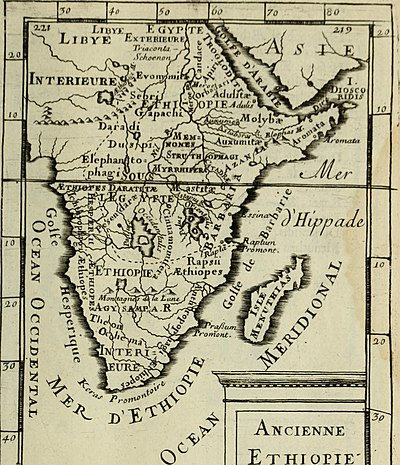Azania (Ancient Greek: Ἀζανία)[1] is a name that has been applied to various parts of southeastern tropical Africa.[2] In the Roman period and perhaps earlier, the toponym has been hypothesised to have referred to a portion of the Southeast Africa coast extending from southern Somalia to the border between Mozambique and South Africa.[3][4] If this is correct, then during classical antiquity Azania was mostly inhabited by Southern Cushitic peoples, whose groups would rule the area until the great Bantu Migration.[5][6]
In 1933, G.W.B Huntingford proposed a theory of Azanian civilization existing in Kenya and northern Tanzania, between the Stone Age and Islamic period. It was supposed that these people were from Ethiopia and Somalia, where they eventually perished around the 14th to 15th-century.[7]
- ^ Periplus of the Erythraean Sea, 15
- ^ Collins & Pisarevsky (2004). "Amalgamating eastern Gondwana: The evolution of the Circum-Indian Orogens". Earth-Science Reviews. 71 (3): 229–270. Bibcode:2005ESRv...71..229C. doi:10.1016/j.earscirev.2005.02.004.
- ^ Richard Pankhurst, An Introduction to the Economic History of Ethiopia, (Lalibela House: 1961), p.21
- ^ The rise of Azania. Snippet w: David Dube. 1983. p. 17.
- ^ JournalInsert Hilton, John (1993-10). "Peoples of Azania". Electronic Antiquity: Communicating the Classics. 1 (5). ISSN 1320-3606. Check date values in: |date= (help).
- ^ Azania. 1983.
- ^ G.W.B, Huntingford (17 April 2022). "The Azanian Civilization And Megalithic Cushites Revisited".

